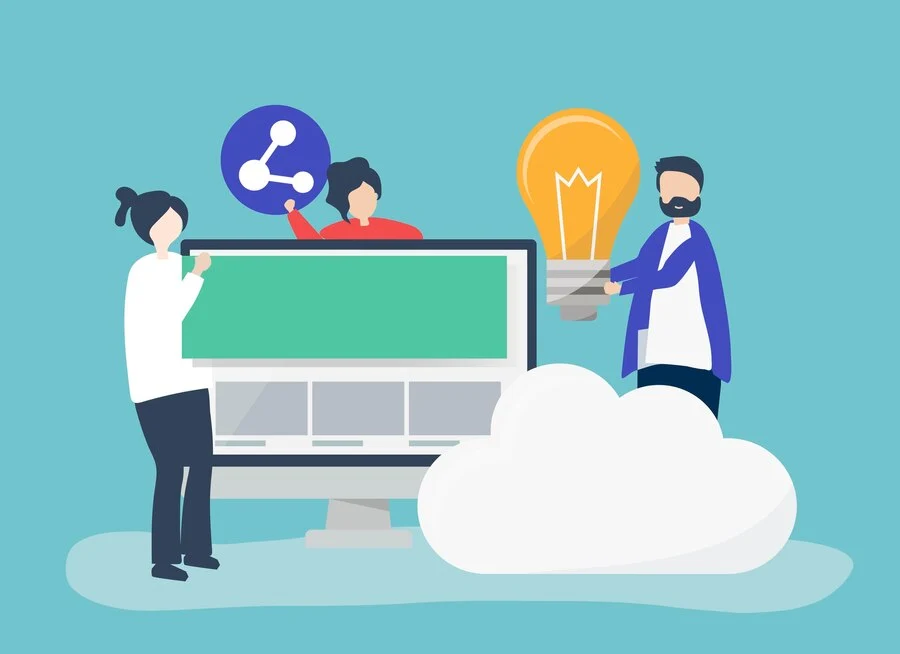The rise of digital internet technologies has brought about many conveniences and opportunities, but it has also created a breeding ground for the infringement of the exclusive rights of content creators.
With the vast amount of content available online, it’s easier than ever for individuals to use copyrighted material without obtaining permission from the copyright owner. But what makes copyright infringement so easy online?
The answer is multifaceted, ranging from the ease of access to copyrighted material, lack of understanding of copyright law, difficulty in enforcement, anonymity, and the sharing culture of the internet.
In this article, we will explore each of these factors in-depth, and highlight why it’s essential for individuals to be aware of these copyright infringement issues and respect the exclusive rights of the content creators.
The internet has revolutionised how we access, share, and consume content. While this has led to an unprecedented level of information exchange and collaboration, it has also made it significantly easier for copyright infringement to occur.
The sheer volume of content available online, coupled with the ease of sharing it with others, has created an environment where infringement of copyright can happen quickly and with little effort.
One of the primary reasons copyright infringement is rampant online is the anonymity provided by the internet.
Users can create multiple accounts and aliases, making it difficult to identify and hold them accountable for their actions.
For example, a person may visit a file-sharing website and download a copy of their favorite album without paying for it. This person may use a fake name and email address to create an account and avoid detection.
If the copyright owner discovers the infringement, they may try to take legal action against the person responsible, but it can be challenging to identify them because they used a fake identity.
In this scenario, the anonymity provided by the internet made it easier for the person to download the copyrighted material without getting caught.
It’s important to note that such activities are illegal and can result in severe consequences if caught.
Obtaining permission from the content creators is necessary to avoid legal issues or any complications and to respect their rights.
The internet has made it incredibly easy for users to access copyrighted material.
A simple search can yield countless sources, making it tempting for individuals to download or share copyrighted content without permission.
For instance, imagine a blogger is writing an article about travel destinations and wants to include some beautiful photographs of beaches.
They go to Google Image Search and type in “beach photos.” They find several high-quality images that are perfect for their article and download them to their computers.
However, these images may be copyrighted and owned by the photographer or another entity, and using them without permission would be considered copyright infringement.
In this scenario, the ease of access to the copyrighted material on the internet led the blogger to unknowingly infringe on someone else’s ownership rights.
Individuals need to be aware that just because something is available online doesn’t mean it’s free to use, and obtaining permission from the copyright owner is necessary before using their original creations.

The internet has eliminated geographical barriers, making it possible for copyrighted content to spread across the globe in an instant. This has led to an increase in the number of people who can potentially infringe on copyrights.
For example, the use of VPNs or virtual private networks, allows users to access the internet from another location, making it harder to trace the user’s location.
In some cases, individuals may use VPNs to access copyrighted material that is not available in their country or to download material without being detected by authorities.
The low cost of digital tools, such as scanners and cameras, and the ease of creating and distributing digital copies of copyrighted material make it easier for individuals to infringe on ownership rights.
For example, a person may scan a printed book and distribute it online for free, which can lead to significant financial losses for the author and publisher.
Digital content is vulnerable to copyright infringement because it is easy to duplicate and distribute.
Unlike physical copies, digital files can be reproduced with little to no loss of quality, making them an ideal target for copyright infringers.
For example, a person may visit a relevant website and download a copy of their favorite movie or TV show without paying for it.
They can then duplicate the digital file and distribute it to others through the internet. This can result in significant financial losses for the copyright owner, as they are not receiving any revenue from the unauthorised distribution of their work.
Another example of the ease of duplication is the copying and distribution of e-books without permission.
A person may obtain a copy of an e-book and make multiple copies of it, which can be easily shared with others over the internet.
This can lead to a significant loss of revenue for the author and publisher of the book, as they are not receiving payment for the additional copies.
In both of these scenarios, the ease of duplication provided by digital technology has made it easier for infringers to distribute copyrighted material without permission.
Individuals need to understand that such activities are illegal and can result in significant consequences if caught.
To ensure compliance with copyright statutes and respect for the rights of copyright owners, obtaining permission is necessary.
File-sharing platforms have made it incredibly simple for users to share copyrighted content.
Sites like BitTorrent and file hosting services allow users to share files with others, often resulting in the unauthorised distribution of copyrighted material.
User-generated content on websites like YouTube, Facebook, and TikTok can sometimes contain copyrighted material.
These platforms have millions of users, making it nearly impossible to monitor and prevent every instance of copyright infringement.
Online copyright infringement is a major problem in the digital age.
With the ease of access to various types of content, it has become all too easy for individuals to copy and distribute copyrighted materials without permission. This not only harms the original creators of such content but also undermines the value of the intellectual property as a whole.
Below are some of the most common types of Internet copyright infringement:
Music and video piracy is one of the most common forms of online copyright infringement.
It involves the unauthorised copying and distribution of copyrighted music or videos.
This can occur through peer-to-peer file-sharing networks or by downloading and sharing files through various websites.
The impact of online music piracy and video piracy can be severe, as it can result in lost revenue for the creators and owners of the content.
Plagiarism is the act of copying someone else’s work and presenting it as your own. This can occur in many forms, including written content, images, and other types of media.
Plagiarism not only violates copyright laws but also undermines the integrity of academic and creative works.

Unauthorised file sharing involves the distribution of copyrighted material through peer-to-peer networks, websites, or other means without permission from the copyright owner. This includes sharing of software, movies, music, and other types of digital content.
Unauthorised file sharing can result in significant financial losses for the original creators and owners of the content.
Software piracy involves the unauthorised use, distribution, or reproduction of copyrighted software. This can include downloading and sharing software without permission or using unlicensed copies of software.
Software piracy can result in lost revenue for software companies and can also pose a risk to users as unlicensed software may contain viruses or malware.
Related Article: Software piracy protection
Image theft involves the unauthorised use of copyrighted images. This can occur through the use of images on websites, social media, or other digital platforms without permission from the copyright owner.
Image theft not only violates copyright laws but also deprives photographers and other creators of their rightful income.
One of the most important steps in protecting your intellectual property is to register your work with the appropriate authorities. This includes having copyright registration with the copyright office in your country.
Registering your work provides legal protection and can help deter infringement.
Regularly monitoring your content can help you identify instances of infringement and take action to protect your intellectual property.
This can include using tools such as Google Alerts or other monitoring services to track your content and identify unauthorised use.
You’re at the right place, contact us to know more.
There are many technological solutions available to help protect your intellectual property. This can include using digital watermarks or other tracking technology to identify your content and prevent unauthorised use.
You can also use encryption technology to protect your content from unauthorised access.
Educating yourself and others about copyright laws and the importance of intellectual property can help prevent infringement.
This can include creating policies and procedures for employees, contractors, and others who may have access to your content.
You can also use educational resources to help inform the public about the importance of intellectual property.
Suggested Reading: Basic copyright law
The unauthorised use or reproduction of legally protected content can have significant consequences.
Such actions, commonly known as infringement, can result in various negative impacts on both the owner of the intellectual property and the party that infringed on their work.
For the owner of the existing copyright material, infringement can lead to reputational harm, loss of income, and legal disputes.
This can be especially detrimental to those who rely on their work as their primary source of income, such as musicians, artists, and authors.
On the other hand, copyright violators can face legal repercussions, including copyright infringement penalties, hefty fines, and even criminal charges.
They may also experience damage to their reputation and loss of potential business opportunities.
The effects of infringement also extend to broader societal impacts.
Infringement can limit the availability of creative works, discourage innovation, and reduce the incentive for artists and other creators to continue producing original content.
To avoid the negative impacts of willful copyright infringement, it is essential to respect the legal rights of intellectual property owners and seek permission before using or reproducing their work.
This can help preserve the integrity of creative works and support the continued production of new and original content.
Jurisdictional differences in copyright laws make it difficult to enforce intellectual property rights.
As laws vary from country to country, it can be challenging to determine which legal framework applies to a particular infringement case.
Copyright holders and law enforcement agencies have limited resources to pursue all instances of copyright infringement.
This has led to a lack of consistent enforcement, allowing infringers to operate with relative impunity.
As mentioned earlier, the anonymity provided by the internet makes it challenging to identify copyright infringers. This can hinder enforcement efforts and deter copyright holders from pursuing legal action.

Content ID systems, such as YouTube’s Content ID and Facebook’s Rights Manager, have been developed to help identify and remove copyrighted material on their platforms.
These systems use advanced algorithms to compare uploaded content with copyrighted material, flagging potential infringements for review.
Digital rights management (DRM) technologies are used to protect copyrighted content from unauthorised access and distribution.
DRM solutions include encryption, digital watermarks, and access controls to limit the sharing of copyrighted material.
Internet service providers (ISPs) can play a crucial role in combating copyright infringement by monitoring and blocking access to websites that host or facilitate the sharing of copyrighted content.
Many countries have implemented laws requiring ISPs to take action against infringing websites.
To avoid infringing on digital copyright protection, here are some general guidelines to follow:
By following these guidelines and being aware of copyright laws, you can minimise the risk of copyright infringement claims and protect your intellectual property rights.
In conclusion, the ease of copyright infringement online is a result of various factors, such as anonymity, ease of access, digital content vulnerability, and legal issues.
While technology has facilitated the infringement of copyrighted material, it can also be utilised to combat this issue through content ID systems, DRM, and the involvement of ISPs.
Governments, copyright holders, and internet users need to work together to address this ongoing problem and protect intellectual property rights in the digital age.
Bytescare Digital Protection provides advanced solutions for these challenges. For comprehensive protection of your digital assets, contact us today.
Copyright infringement is easy online due to factors such as anonymity, ease of access to copyrighted material, the vulnerability of digital content, and legal challenges in enforcement.
Digital rights management (DRM) is a set of technologies used to protect copyrighted content from unauthorised access and distribution, often through encryption, digital watermarks, and access controls.
ISPs can help combat copyright infringement by implementing measures such as:
1. Monitoring network traffic for infringing content.
2. Blocking access to known infringing websites.
3. Implementing a “copyright notice and takedown” system for removing infringing content.
4. Working with content owners and law enforcement agencies to identify and prosecute infringers.
5. Educating their customers about copyright laws and the importance of legal content sources.
To reduce copyright infringement online, measures such as increasing public awareness, implementing stricter laws and penalties, promoting the use of legal content sources, and utilising technologies such as content ID systems and DRM can be taken.
Additionally, monitoring and blocking access to infringing websites can also be effective.
The internet offers immediate access to a vast array of copyrighted content. This convenience, coupled with the ability to easily share material, tempts users to distribute copyrighted works without obtaining permission from copyright owners.
Copyright infringement can lead to significant financial losses for copyright owners, undermine the incentive for creating new works, and negatively impact the economy. It also harms consumers by potentially reducing the availability and diversity of creative content.
Yes, under certain conditions such as fair use or fair dealing, using copyrighted material without permission can be legal. These conditions typically include use for criticism, comment, news reporting, teaching, scholarship, or research. However, the boundaries of fair use are subjective and vary by jurisdiction.
Safeguard Your Digital Assets with our Cutting-Edge Security Solutions
Elevate your digital stature and shield your priceless reputation from harm. Select Bytescare for ultimate protection against piracy, defamation, and impersonation.